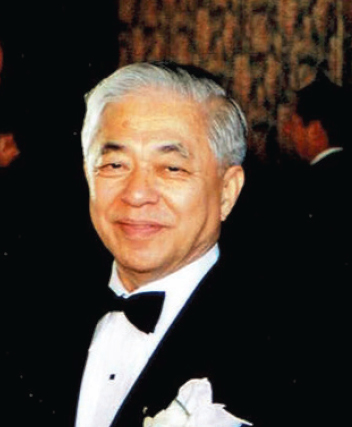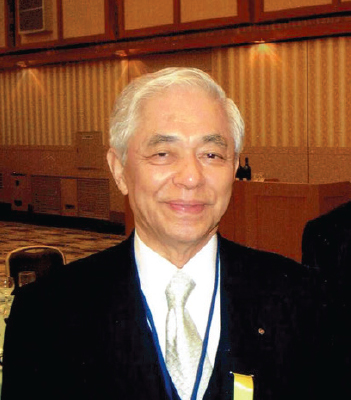

JUN-ICHI NISHIZAWA
1926–2018
Elected in 2010
“For contributions to the static induction devices, dislocation-free semiconductor processing, and optical device technologies.”
BY TATSUO ITOH
JUN-ICHI NISHIZAWA, professor emeritus of Tohoku University, excelled as a scientist, engineer, university president, and advisor to local governments. He was born September 12, 1926, in Sendai, Japan, and passed away October 21, 2018, at age 92 in the presence of family in his birth city.
He was born into an academic family. His father, Kyosuke Nishizawa, was a professor of inorganic chemistry at Tohoku University, which is where Jun-ichi earned his bachelor’s degree in 1948 and 12 years later his PhD degree, both in engineering. In 1953 he was hired at the university’s Research Institute of Electrical Communication and went on to serve as institute director (in both 1983–86 and 1989–90). His younger brother, Taiji Nishizawa, also taught at the university, as a professor of material science.
During his indefatigable career Jun-ichi was also president of Tohoku University (1990–96), first president of the Iwate Prefectural University (1998–2005), first president of the Tokyo Metropolitan University (2005–09), and senior advisor and specially appointed professor at Sophia University in Tokyo (2009–13). In addition, he advised local governments in Miyagi prefecture and Sendai city; both the governor and mayor appreciated his various contributions.
Jun-ichi Nishizawa was not only a dedicated professor and mentor but also a prolific inventor, credited for many sophisticated semiconductor devices for high-frequency and/or high-power devices, often produced in collaboration with colleagues such as Yasushi Watanabe. Starting in 1950 with his invention of the static induction transistor and PIN diode, he went on to introduce the avalanche photodiode (1952), solid-state maser (1957), tunnel-injection transit-time (TUNNETT) diode (1958), and static induction thyristor (1973).
To realize these concepts and devices, he also developed novel technologies, such as ion implantation, perfect crystal growth, epitaxial growth with temperature difference method under controlled vapor pressure, and atomic layer deposition, and other process techniques that significantly advanced the semiconductor industry. For example, he demonstrated that the ideal static induction transistor had an oscillation frequency of 780 GHz (1979), and calculated that the ideal static induction tunneling transistor had a cut-off frequency well into the THz range; for these technical achievements a feature article dubbed him “THz Shogun.”1
In the optoelectronics field, Nishizawa invented the semiconductor optical maser, laser diodes, high-intensity light-emitting diode (LED), and optical glass fiber (patent filed in 1964). He successfully established three essential components of optical communication—laser diode as transmitter, PIN (photo)diode as receiver, and optical fiber as transmission line—to create a fully integrated optical communication system.
He proposed direct-current power transmission technology using his high-power devices. At an OPEC general meeting in 1986 he gave a presentation on a system that could send hydroelectric power to factories and the environs of
___________________
1 Siegel PH. 2015. Terahertz pioneer: Jun-ichi Nishizawa “THz Shogun.” IEEE Transactions on Terahertz Science and Technology 5(2):162–69 (https://ieeexplore.ieee.org/document/7047877). The article presents a very engaging portrait of Nishizawa.
major cities via DC power transmission as a global warming countermeasure.2
The Semiconductor Research Institute was created 1961, thanks to his tremendous efforts, and he became director in 1968. It was affiliated with but independent of Tohoku University. In 2008 it was donated to Tohoku University and named the Jun-ichi Nishizawa Memorial Research Center.
For more than 40 years, every year in the summer off-season at skiing resort Mt. Zao, he held a 3-day research seminar for young scientists and engineers to discuss emerging semiconductor technologies. After dinner, spontaneous discussions arose among participants and often continued late into the night. Many young engineers were impacted by and influenced each other during these seminars.
His seminal contributions were internationally recognized. He was a life fellow of the Institute of Electrical and Electronics Engineers (IEEE) and a fellow of the Physical Society of Japan, Russian Academy of Sciences, and Polish Academy of Sciences. In 2010 he was elected a foreign member of the NAE.
Among the many awards bestowed on him were the IEEE’s Jack A. Morton Award (now the Andrew S. Grove Award) (1983) for “invention and development of the class of static induction transistors (SIT) and for advances in optoelectronic devices,” and Edison Medal (2000) for “contributions to materials science and technology, and the invention of the static induction transistor.” In 2002 the IEEE created the Jun-ichi Nishizawa Medal in his honor; it is presented for “outstanding contributions to material and device science and technology, including practical application.”
In Japan he was designated a Person of Cultural Merit (1983), the country’s highest civilian honor, and received the Order of Cultural Merit from His Majesty the Emperor (1989). He was also awarded the Japan Academy Prize (1974), the government’s Purple Ribbon Medal (1975), the Honda Prize
___________________
2 This and other achievements are described in an interview recorded at Sophia University, published in the May 2011 Japan Quality Review (https://jqrmag.com/e/pdf/01_Interview.pdf).
(1986), and the First Class Order of the Sacred Treasure (2002), among many others.
Jun-ichi Nishizawa leaves behind his wife, three children, and many colleagues and former students who are distinguished professors or excellent scientists, engineers, and human beings because they knew him and were influenced by him.






